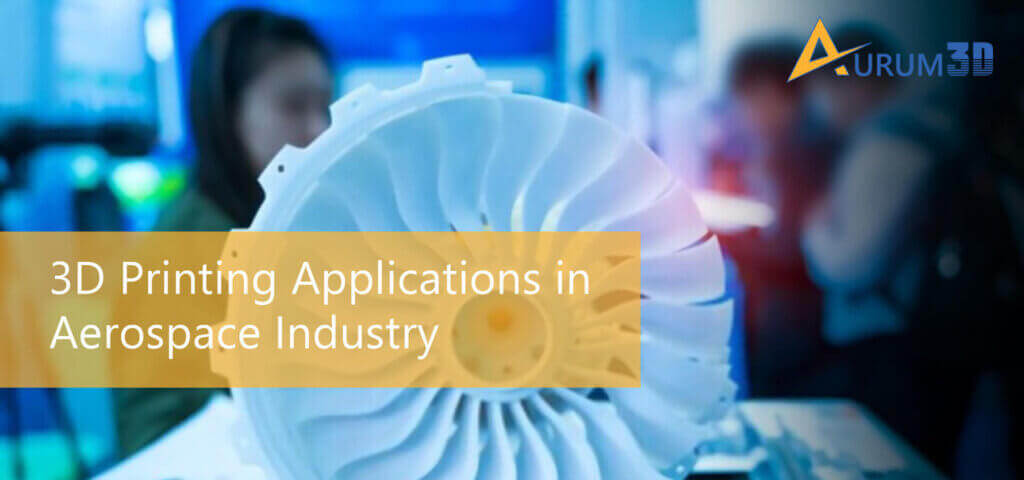The 3D printing technologies have been transforming all industries by producing three-dimensional objects based on the commands given by software programs. Aerospace is one of the industries that adopted 3D printing technology early. But the new 3D printing applications and use cases in the aerospace industry is being created regularly. The consistent growth of the worldwide 3D aerospace 3D printing market depicts the transforming impact of additive manufacturing technology.
According to a market forecast report released by Fortune Business Insights,
“The global aerospace 3D printing market size, which was valued at USD 1359.1 million in 2018, is projected to reach USD 6745.5 million by 2026, at a CAGR of 22.17% during the forecast period.”
At present, aerospace manufacturers leverage 3D printing technology to design, build and maintain both commercial and military aircraft. Some manufacturers 3D-print replacement parts, while others leverage 3D printing technologies to design and evaluate complex aircraft parts. That is why; the use cases or applications of 3D printing in the aerospace industry vary across aerospace manufacturers. We can assess the 3D printing applications in aerospace based on a slew of interesting use cases.
9 Interesting Use Cases of 3D Printing in the Aerospace Industry
Rapid Prototyping
Like other industries, the aerospace industry uses rapid prototyping to produce ready-to-use parts from initial design concepts. 3D printing technologies enable aerospace companies to produce and evaluate multiple design variations by producing fully-functional parts. The engineers can use the appropriate 3D printer and 3D printing material to create prototypes rapidly with varying forms, fits, and functionalities. In addition to accelerating aircraft design cycles, 3D printing helps companies to reduce time to market.
Producing Functional Parts on Demand
Many aerospace manufacturers these days prefer 3D-printing components and parts instead of manufacturing. Unlike conventional manufacturing technologies, 3D printing produces components for both existing and upcoming aircraft in a few hours.
Also, it creates opportunities for engineers to experiment with new materials while building complex engine parts or repair parts of the upcoming aircraft. The engineers can further use a 3D printer to manufacture the repair parts, complex engine structures, and complex engine components for individual aircraft on demand.
Replacing and Consolidating Multiple Parts
The leading manufacturers explore ways to reduce the number of parts. They boost the aircraft’s performance and energy efficiency by replacing multiple parts with a single part. 3D printing technologies make it easier for engineers to design and produce a single part or component that can replace hundreds of components. The engineers also have the option to produce and evaluate multiple versions of the consolidated component quickly without investing extra resources.
Delivering Older Aircraft Parts
As mentioned earlier, the engineers can use 3D printers to produce aircraft parts from digital files on demand. Most aerospace companies these days leverage 3D printing technologies to produce older aircraft parts in a few hours. They have already set up dedicated additive manufacturing facilities to speed up repair and maintenance activities by producing both flying and non-flying parts of older aircraft. In addition to accelerating repair and maintenance, additive manufacturing facilities help aerospace companies to eliminate the need to maintain an inventory of parts and components.
Experimenting with Lightweight Materials
While designing and building aircraft, engineers frequently look for the option to reduce fuel consumption and improving energy efficiency by reducing the aircraft’s mass. The 3D printing technologies help engineers to reduce the mass of the aircraft by experimenting with varied lightweight and high-strength materials. The engineers can use the right industrial 3D printer to produce components and parts using lightweight materials with minimal waste. Also, 3D printing technologies enable them to evaluate lightweight materials by printing a variety of components on demand.
Building Tooling Fixtures
Aerospace companies cannot produce complex and innovative tooling fixtures using conventional manufacturing techniques. They rely on advanced additive manufacturing technologies to build tooling fixtures without investing in extra resources. Along with reducing risk and uncertainties, 3D printing technologies enable engineers to improve product quality by experimenting with various designs and testing the parts repeatedly.
Sustaining Low Volume Production
The conventional manufacturing methods make it difficult for aerospace companies to sustain low-volume production in the long run. The aerospace manufacturers have to set up and maintain facilities to produce a single item whenever the need arises.
But the advanced additive manufacturing technologies enable aerospace companies to produce a single aircraft part simply using a 3D printer. The engineers can produce the functional part in a few hours from a digital file. Also, they can 3D-print parts with complex geometries without investing in additional tooling.
Repairing Functional Parts
In addition to producing functional parts on-demand, 3D printing technologies help engineers to repair functional parts in a short amount of time. The engineers can leverage advanced additive manufacturing technologies like direct energy deposition to repair functional parts by providing feedstock material in two distinct formats – wire form or metal powder.
Direct energy deposition technology supports a wide range of metals, including stainless steel, tool steel, aluminum alloy, titanium alloy, maraging steel, and nickel-copper. Some of these materials are less expensive than the metal powder used in 3D printing. At the same time, the technology is effective in producing parts of varying sizes and definitions, while allowing engineers to control the component’s gain structure.
Curtailing Supply Chain Cost
3D printing technology helps aerospace manufacturers to reduce the number of suppliers and partners significantly. They can easily shorten the supply chain by replacing multiple aircraft parts with a single and consolidated part. Also, they can use 3D printers to produce various aircraft parts in a short amount of time. Hence, they are not required to rely on multiple suppliers to produce individual parts. The leading aerospace companies have been switching to localized production by integrating the supply chain vertically.
Aerospace companies have been using 3D printing technologies for a variety of purposes. Hence, the use cases of 3D printing vary from one aerospace company to another. But the varying use cases depict the importance and applications of 3D printing technology in the aerospace industry.
About Aurum3D:
3D Printing in Bangalore is witnessing a lot of changed. Aurum3D is one of the leading 3D printing companies in Bangalore. We provide custom 3D printing services to leading aerospace companies across the world. Feel free to get in touch with our solutions experts for all your requirements.

